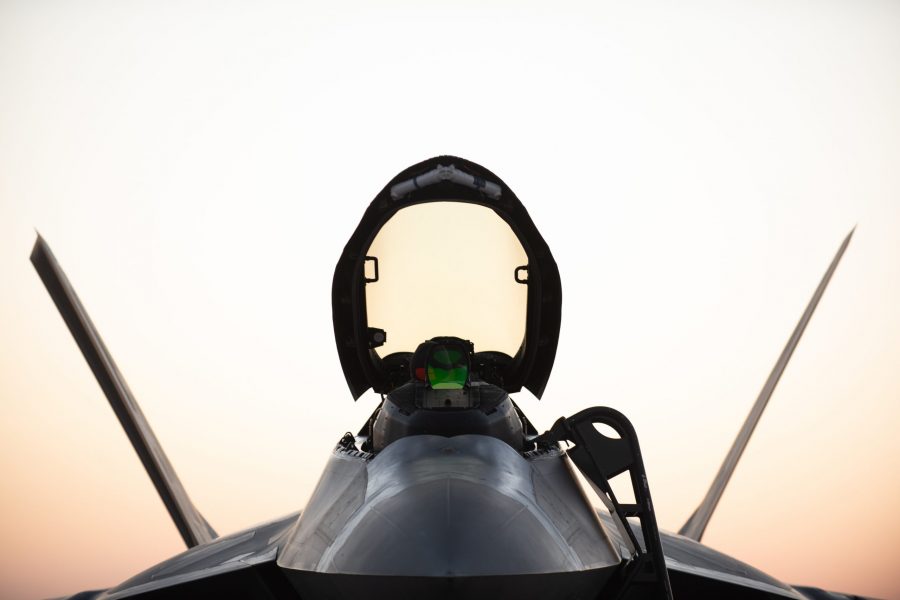The Air Force’s fleet in fiscal 2019 maintained an overall mission capable rate of 70.27 percent, a slight increase from the previous year. Although some key combat aircraft, such as the fifth-generation F-22 Raptor, sustained low capability rates, service officials say the numbers don’t tell the whole story.
Air Force officials say the mission capable rate—a snapshot of how much of a certain fleet is ready to go at a given time—is an inaccurate portrayal of the service’s overall health. Air Force Chief of Staff Gen. David Goldfein, in a September 2019 interview with Air Force Magazine, said the service instead wants to highlight how deployable a fleet is within a short period of time.
“How many force elements do we have—fighters, bombers, tankers—across all of the Air Force, and how are we doing relative to the time all of those forces need to be ready,” Goldfein said.
For example, Goldfein pointed to the May 2019 deployment of a task force of B-52s to the Middle East. The bombers, from Barksdale Air Force Base, La., had two days to deploy, and immediately began flying combat missions, even though at the time the B-52 fleet had a mission capable rate of 65.73 percent.
The fleet of B-1Bs, long noted for anemic mission capable rates that at a point dwindled to the single digits, has recently improved, reaching a 46.42 percent mission capable rate in 2019. In recent months, USAF Lancers have deployed across the globe as part of bomber task forces, flying training missions in Guam, Estonia, and Japan. The service is addressing the health of the fleet through improved fleet management, increased maintenance, and a dedicated structural repair line at Tinker Air Force Base, Okla.
The B-2 stealth bomber in 2019 had a rate of 60.47 percent.
The mission capable rate of the service’s fighters became a focal point in 2018, as then-Defense Secretary Jim Mattis ordered the Air Force and Navy to improve their rates to 80 percent. The order quickly fell by the wayside, as Air Force fighters never met the mark, and service leaders moved on to other methods to measure readiness. Gen. Charles Q. Brown Jr., the nominee to be the next Chief of Staff, told the Senate Armed Services Committee earlier this month the Air Force is instead letting commanders decide whether their aircraft are ready.
“The Air Force has made improvements in the readiness of its units. However, the continued high demand for Air Force capabilities continues to impact recovery,” Brown wrote in answers to advance policy questions before his confirmation hearing. “If confirmed, I will continue the effort [Chief of Staff] Gen. [David] Goldfein has put on readiness recovery with a focus on recruiting, training, and retaining high-quality Airmen, driving down the average age of our aircraft fleets through modernization, and working with our combatant commanders on balancing current operations tempo with time for our Airmen to train for full-spectrum combat operations.”
In fiscal 2019, the F-22 fleet was the least ready among fighters at a rate of 50.57 percent. The F-35A had a rate of 61.60 percent, F-15Cs at 70.05 percent, F-15Es at 71.29 percent, and F-16Cs at 72.97 percent. The A-10 attack jet had a rate of 71.20 percent.
In mobility, the C-17 strategic airlifter maintained a rate of 82.23 percent and the C-130J tactical airlifter had a rate of 77.02 percent. KC-10s came in at 79.37 percent, while KC-135Rs had a mission capable rate of 72.50 percent.
For helicopters, the HH-60 Pave Hawk maintained a rate of 66.2 percent, while the Vietnam-era UH-1N had a rate of 82.42 percent. The tiltrotor CV-22 Osprey had a rate of 53.45 percent in 2019.
Here’s a breakdown of all of USAF’s aircraft and their 2019 MC rates:
Mission System 2019 Mission Capable Rate A-10C 71.2% AC-130J 86.12% AC-130U 85.62% AC-130W 80.22% AT-38B 74.62% B-1B 46.42% B-2A 60.47% B-52H 65.73% C-12C 99.05% C-12D 100% C-12F 92.4% C-12J 100% C-130H 65.51% C-130J 77.02% C-17A 82.23% C-21A 100% C-32A 90.24% C-37A 93.85% C-37B 86.47% C-40B 89.48% C-40C 85.9% C-5M 63.16% CV-22B 53.45% E-3B 74.41% E-3C 73.19% E-3G 74.36% E-4B 64.75% E-8C 67.36% EC-130H 73.19% EC-130J 57.38% F-15C 70.05% F-15D 72.45% F-15E 71.29% F-16C 72.97% F-16D 70.37% F-22A 50.57% F-35A 61.6% HC-130J 79.81% HC-130N 68.13% HC-130P 61.52% HH-60G 66.20% KC-10A 79.37% KC-135R 72.5% KC-135T 71.11% KC-46A 63.11% LC-130H 40.28% MC-12W 100% MC-130H 68.65% MC-130J 77.54% MC-130P 28.07% MQ-1B 99.52% MQ-9A 89.32% OC-135B 82.46% RC-135S 90.39% RC-135U 91.07% RC-135V 74.1% RC-135W 69.49% RQ-4B 75.75% T-1A 60.51% T-38A 74.48% T-38C 63.05% T-6A 63.29% TC-130H 26.32% TC-135W 84.8% TE-8A 73.42% TH-1H 74.63% TU-2S 74.96% U-2S 78.39% UH-1N 82.42% VC-25A 92.86% WC-130J 56.2% WC-135C 63.05% WC-135W 80.14%

